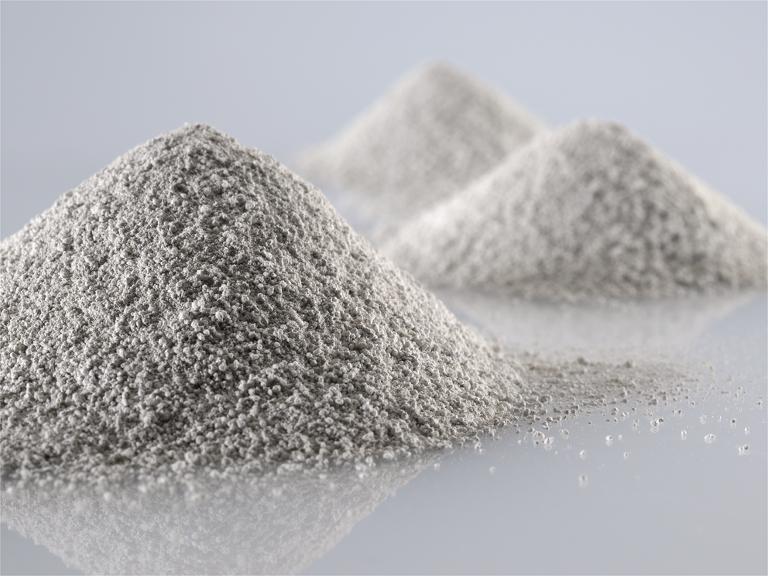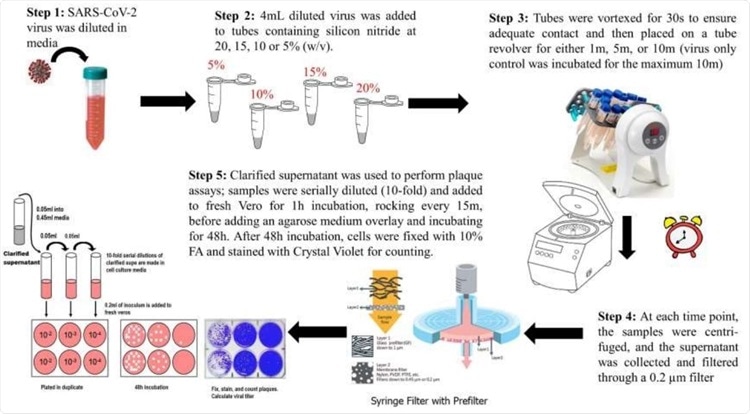COVID-19 Disinfectants: Study Shows Silicon Nitride Used In Medical Implants Might Be A Good Disinfectant For SARS-CoV-2
Source: COVID-19 Disinfectants Sep 01, 2020 5 years, 3 months, 2 weeks, 2 days, 17 hours, 28 minutes ago
COVID-19 Disinfectants: Researchers from Virginia Polytechnic Institute State University, George Mason University-Virginia and SINTX Technologies Inc-Utah in a new study have demonstrated that the synthetic compound silicon nitride, which is used in medical implants and high mechanical performance engineering applications, is capable of inactivating the SARS-CoV-2 coronavirus at varying concentrations without causing cell cytotoxicity. This new study finding could be further researched in its utility as a disinfectant for SASR-CoV-2 and also as coating surfaces to make it coronavirus-proof.

The study findings were published on a preprint server that has yet to be peer-reviewed.
https://www.biorxiv.org/content/10.1101/2020.08.29.271015v1
Studies have shown that the coronaviruses are capable of surviving long-term on many surfaces. The earlier pathogenic coronavirus SARS-CoV, which was responsible for the 2003 outbreak of severe acute respiratory syndrome, was found to survive for up to 9 days in suspension, and 6 days in the dried state. Another pathogenic coronavirus, HuCoV-229E, which is responsible for upper respiratory infections in humans, has been found to live for up to 5 days on a variety of surfaces, from glass to stainless steel.
The present coronavirus SARS-CoV-2, has also been detected live at up to 72 hours on plastic, copper, and cardboard, and for up to 7 days on surgical masks. Thus, the need for an effective surface disinfection is critical.
To date, various technologies have been used for virus control including disinfectants, irradiation, and the use of metals like copper, zinc, iron, and silver, which rapidly inactivate viruses. Copper alloys, for instance, are used to create antimicrobial surfaces in healthcare facilities and cut down the incidence of nosocomial infections.
So far disinfectants found to be effective in this situation include the quaternary ammonium compounds like ammonium chloride. These disrupt the protective lipid envelope of the virus and thus inactivate it. These compounds are therefore used to clean healthcare surfaces and remove persistent viral particles.
However studies are emerging that quaternary ammonium compounds can cause lots of harmful health effects in humans and already certain countries an states are banning its use while it under review by the U.S. Environmental Protection Agency.
https://www.thailandmedical.news/news/breaking-covid-19-disinfectants-warning-about-dangers-of-quat-quaternary-ammonium-compounds-disinfectants-currently-being-used
The present research focuses on silicon nitride, Si3N4, which is a non-oxide ceramic used under U.S. FDA approval for spinal implant surgery. Such devices have shown that the long-term outcomes are excellent when silicon nitride is used for both lumbar and cervical fusion, compared to other biomaterials used in similar situations like bone grafts, titanium, and polyetheretherketone.
It was found that in an aqueous environment, silicon nitride spinal implants are hydrolyzed from the surface, releasing ammonia at the micro
scopic level. This molecule is then converted into ammonium, nitrous oxide, and reactive nitrogen species, which suppress the growth and proliferation of bacteria. This is perhaps the reason for the intrinsic antibacterial properties of this compound, and why its use in spinal implants is associated with a lower incidence of bacterial infections, as low as 0.006%, in contrast to the other biomaterials that have as high an incidence of infection as ~3% to 18%.
The virucidal activity of Si3N4 was demonstrated when viruses were exposed to an aqueous solution of silicon nitride, it inactivated viruses like the influenza virus H1N1, enterovirus and feline calicivirus.
In previous research it was reported that silicon nitride in aqueous suspension also inactivates SARS-CoV-2 as well as copper ions. However, a significant advantage is that silicon nitride is not cytotoxic to mammalian cells, unlike copper.
https://www.biorxiv.org/content/10.1101/2020.06.19.159970v1
The study team in the current research tried to determine that exposure to silicon nitride would not be toxic to mammalian cells in vitro but would inactivate the virus at a rate dependent on the duration and dose of exposure.
Interestingly the team found that when they used suspensions of silicon nitride at 5, 10, 15, and 20% (w/v), on Vero cells in culture, there was no difference in cell viability at 24 or 48 hours after exposure at any concentration except with the highest. In fact, the cell viability improved by about 10% at 48 hours after being exposed to 5% and 10% suspensions for 10 minutes. This suggests a stimulatory effect of silicon nitride on cell growth or metabolism.
However about 20% w/v, the cell viability did show a small decline, of about 10%, at 48 hours after being exposed to the silicon nitride.
The study team also found that at the same concentrations, silicon nitride exposure caused inactivation of SARS-CoV-2, as evaluated by plaque assay. Those viruses which were exposed to cell culture media showed 4.2 x 103 PFU/mL. In contrast, all concentrations of Si3N4 reduced viral titers to varying extents. At one minute of exposure to a 5% suspension, the viral titer went down by 0.8 log10, with a 10% suspension by 1.2 log10, at 15% by 1.4 log10, and with a 20% suspension by 1.7 log10. The same trend was observed at 5 and 10 minutes.
It must be note that this reduction in viral titer corresponds to 85%, 93%, 96% and 98% inhibition of viral particles at 5%, 10%, 15% and 20% suspensions, respectively. Inhibition is almost 100% when the exposure is continued for longer durations and at higher concentrations, such as 10 minutes at 20% w/v.
Hence the study team observed that Si3N4 has a strong inhibitory effect on SARS-CoV-2 proliferation but no cytotoxic effect on mammalian cells.
The team says that these findings are remarkable since a single minute of exposure to a 5% solution of silicon nitride reduces the number of active viral particles by 85%. Still, the cell is minimally affected even 48 hours after exposure at a 20% concentration of the substance. This agrees with prior research that shows that Si3N4 has a remarkable “dual effect” in that it not only produces viral inactivation but also suppresses the formation of bacterial biofilm, but spares mammalian cells.
The findings are also concordant with another recent study that shows the virus to be rapidly inactivated by exposure to 15% silicon nitride, as well as other data that relates this to antiviral effects of Si3N4 on a range of single-stranded RNA viruses as well, as mentioned above.
https://www.biorxiv.org/content/10.1101/2020.06.19.159970v1
A wide spectrum of applications, such as developing fabrics for personal protective equipment like masks and surfaces on commonly-touched items of furniture could be developed for use with Si3N4.
The study team suggests several antiviral actions of Si3N4, such as the ability of the material to release ammonia released at a slow and controlled rate from the surface. This gives rise to reactive nitrogen species that fragment the viral RNA.
Also, ammonia also gives rise to free electrons and silanols with an excessive negative charge in aqueous solutions.
Furthermore the silicon nitride surface carries protonated amino groups, Si–NH3+, which are similar to the N-terminal lysine end of the virus, C– NH3. This could lead to the competitive binding of the virus to this material and its subsequent inactivation.
 The Testing Procedure
The Testing Procedure
Significantly silicon nitride has several superior features over other potential antimicrobial surfaces in that it continues to offer sustained antiviral activity because of these hydrolytic reactions taking place at its surface, rather than a single disinfectant action that will require repeated and meticulous applications. Also, even though copper is known to have potent virucidal activity, it is also toxic to cells. On the other hand, Si3N4 implants have been in use for years with successful tolerance in the human body.
It should also be noted that Si3N4 is a highly versatile material. It has been used in sintered form to make polymers, bioactive glasses, and other composite ceramics and coatings that promote bone growth and retain its antibacterial properties.
However despite these obvious advantages, the study is limited by the use of powdered doped Si3N4 rather than the actual implant-grade material. Thus, further research is required to demonstrate that when used as part of a material or coating, such as paint, metal, fabric, or ceramic, it will continue to retain virucide activity.
For every application, the chemical process underlying the elution of ammonia and its conversion into virucidal compounds will need optimization.
Additional adjustments may also be required to increase the rate of release of these compounds by altering the composition of this doped form of Si3N4, to enhance its effectiveness against viruses and bacteria and its safety to the host cells.
Importantly, it is still unclear whether aqueous suspensions are truly necessary or simple physical contact with Si3N4 particles is enough to inactivate the virus or both are required in unison.
Dr Caitlin W. Lehman from the Department of Biomedical Sciences and Pathobiology, Virginia Polytechnic Institute and State University told Thailand Medical News, “While Si3N4 is not suitable for ingestion or inhalation, its antiviral activity, which is not limited to SARS-CoV-2, suggests that it may be a fortuitous platform to engineer surfaces and personal protective equipment to discourage viral persistence, and thereby control the spread of COVID-19 and other diseases.”
For more on
COVID-19 Disinfectants, keep on logging to Thailand Medical News.

